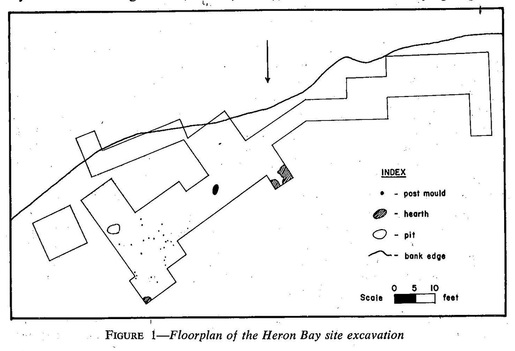
James Wright's (1967) report on the Laurel Tradition describes the remains of a probable structure from the Heron Bay site (DdIn-1) in the Thunder Bay District of Ontario. Again, I thank Chris Ellis for checking my "Most Wanted" list and sending me the relevant pages from the report.
As described by Wright (1967:5, 8) and shown in the figure to the right, the northeastern portion of the area excavated at Heron Bay contained "a clustering of twenty-five post moulds which may represent a house structure." The posts appear to represent the remains of a circular/elliptical structure that may have been about 3 m in diameter. Wright (1967:8) stated that recreating a house from the posts would be an "exercise in fantasy."
Although Wright (1967:8) dismissed the results of a radiocarbon determination (GSC-208) from the site as "unacceptable," the age estimate of about AD 610 is within the age range of what is now accepted as associated with Laurel (see the references listed in the Canadian Archaeological Association's discussion of the C14 date).
The structural remains from Heron Bay will be included as Structure 2257 in the database.
As described by Wright (1967:5, 8) and shown in the figure to the right, the northeastern portion of the area excavated at Heron Bay contained "a clustering of twenty-five post moulds which may represent a house structure." The posts appear to represent the remains of a circular/elliptical structure that may have been about 3 m in diameter. Wright (1967:8) stated that recreating a house from the posts would be an "exercise in fantasy."
Although Wright (1967:8) dismissed the results of a radiocarbon determination (GSC-208) from the site as "unacceptable," the age estimate of about AD 610 is within the age range of what is now accepted as associated with Laurel (see the references listed in the Canadian Archaeological Association's discussion of the C14 date).
The structural remains from Heron Bay will be included as Structure 2257 in the database.
 RSS Feed
RSS Feed
